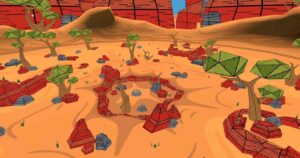Dreams of Another is stepping deeper into immersion. The abstract platformer, known for its floating islands and strange geometries, now includes a first-person mode built specifically for PlayStation VR2. It’s not just a camera toggle — the update reworks movement and perspective for VR, changing how the game feels moment to moment.
While third-person remains available, this new view shifts the experience into something closer to a walking simulator crossed with environmental puzzles, stripping back some of the distance that used to define the game’s tone.
First-person shifts the platforming rhythm
In third-person, the game played like a classic indie platformer with a floaty, dreamlike aesthetic. Movement was tight but indirect, focused more on spacing than precision. With first-person enabled, that changes. Players now occupy the world directly, making jumps and landings feel heavier and more deliberate.
It alters the way players approach vertical puzzles and floating architecture. What felt surreal at a distance now feels more physical, even when the logic of the world remains offbeat. It’s less about watching your character traverse the space and more about experiencing the weirdness firsthand.
Controls adapted for VR hardware
The update doesn’t just switch the camera. Input has been reworked for PSVR2’s Sense controllers, with movement tuned for smooth navigation and quick resets. Comfort options are included for snap-turning and vignette-based motion reduction.
It’s clear the shift wasn’t tacked on. The level design remains intact, but traversal accommodates the new perspective without pushing motion sickness. That’s especially important in vertical areas, where balance and fall distance could otherwise be disorienting.
Visuals remain stylized and minimal
Dreams of Another was never about photorealism. The game’s identity comes from sparse geometry, drifting structures, and tonal lighting. That holds up in VR. The simplicity actually helps — there’s little clutter, and the focus stays on navigation and atmosphere.
Environments lean on open space, which works well with head tracking. There’s no claustrophobia or UI overload. It’s a clean presentation, where form follows mood more than function.
Optional mode, not a replacement
This new first-person mode is additive, not mandatory. Players can toggle between perspectives depending on preference or comfort. That flexibility gives the game a wider appeal — it can be played like a meditative journey or like a hands-on platforming challenge, depending on how much you want to be inside it.
It’s a smart move for a title this abstract. Instead of redefining what the game is, the mode reframes it. And on PSVR2, where comfort and clarity often clash with ambition, it’s rare to see an update that balances both without dropping either.
Dreams of Another doesn’t become a new game with this update, but it does gain a new texture. And for players who want surrealism they can physically step into, it just got a lot closer.
Beta Hunter & Brutally Honest Reviewer
He plays what others fear. BETATESTER-X dives into broken builds, awkward alphas, and early-access chaos so you don’t have to. No hype. No mercy. Just raw, first-hand feedback from the trenches of unfinished games.




